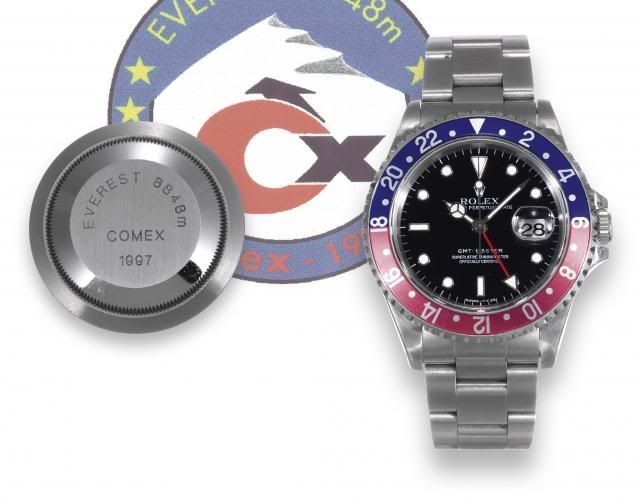Found this on the Dutch Rolex Forum, thought it would be interesting to share here..

[...] The first thing you'll notice about this watch that makes it different from all other Comex Rolexes is that it's a GMT, not a Submariner or Sea-Dweller, meaning it is NOT a diving watch. Comex is, after all, the deep sea diving group that works with all off-shore oil companies, so it makes sense their watches would be divers. The other attribute you'll notice is missing on this Comex GMT is the name "COMEX" on the face. Having that name on the face of your Rolex is half the fun of owning a piece from this diving company; it acts as a secret seal that identifies you to other real watch fans as someone who "gets it".
However, having a Comex Rolex without the name on the front might be even more fun when talking to real watch guys, although it won't get you noticed quite as quickly when you're out and about.
Anyways, we digress. So why is this watch an aviator's watch and why does it not look like any other Comex Rolex? The short answer is, it was never meant to go under water. This watch was used in Comex's Everest III operation, where eight volunteers went into a hypobaric chamber meant to simulate an ascent on Mt. Everest. Several tests were run on the participants, including those on the cardiac and nervous systems to see how they would fare at 8,848 meters.
The results were eventually published in the American Journal of Respiratory and Critical Care Medicine, the report titled "Operation Everest III (Comex '97): Modifications of Cardiac Function Secondary to Altitude-induced Hypoxia, An Echocardiographic and Doppler Study", can be found here:
http://ajrccm.atsjournals.org/cgi/co...ract/161/1/264
These Rolexes were given to the eight participants, although it seems that it was not just GMT's given out but Explorers as well (which makes sense due to the model's history with Mt. Everest). [...]
(Source: hodinkee.com)

[...] The first thing you'll notice about this watch that makes it different from all other Comex Rolexes is that it's a GMT, not a Submariner or Sea-Dweller, meaning it is NOT a diving watch. Comex is, after all, the deep sea diving group that works with all off-shore oil companies, so it makes sense their watches would be divers. The other attribute you'll notice is missing on this Comex GMT is the name "COMEX" on the face. Having that name on the face of your Rolex is half the fun of owning a piece from this diving company; it acts as a secret seal that identifies you to other real watch fans as someone who "gets it".
However, having a Comex Rolex without the name on the front might be even more fun when talking to real watch guys, although it won't get you noticed quite as quickly when you're out and about.
Anyways, we digress. So why is this watch an aviator's watch and why does it not look like any other Comex Rolex? The short answer is, it was never meant to go under water. This watch was used in Comex's Everest III operation, where eight volunteers went into a hypobaric chamber meant to simulate an ascent on Mt. Everest. Several tests were run on the participants, including those on the cardiac and nervous systems to see how they would fare at 8,848 meters.
The results were eventually published in the American Journal of Respiratory and Critical Care Medicine, the report titled "Operation Everest III (Comex '97): Modifications of Cardiac Function Secondary to Altitude-induced Hypoxia, An Echocardiographic and Doppler Study", can be found here:
http://ajrccm.atsjournals.org/cgi/co...ract/161/1/264
These Rolexes were given to the eight participants, although it seems that it was not just GMT's given out but Explorers as well (which makes sense due to the model's history with Mt. Everest). [...]
(Source: hodinkee.com)


 :
:

Comment